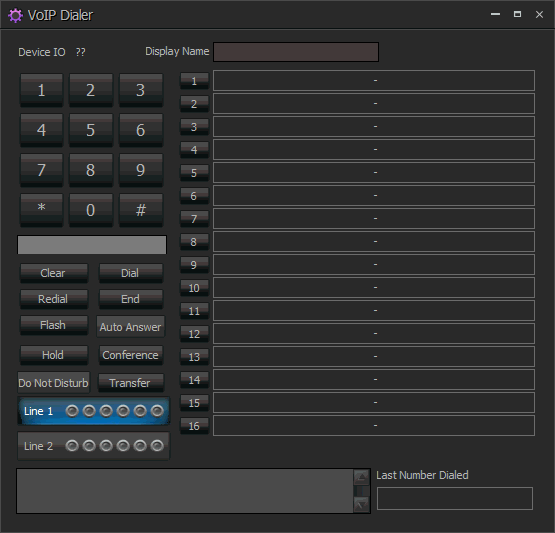Dialer
The Dialer block provides an interface for the dialing functions of an analog or VoIP telephone interface. If no VoIP or TI component objects are available the following dialog is shown:

Initialization Dialog
Upon creating a new Dialer block, it must be linked to an existing set of telephone interface blocks. Linking it to an analog telephone interface creates a “TI Dialer” block which controls a single telephone line, whereas linking it to a VoIP telephone interface creates a “VoIP Dialer” block which controls two VoIP phone lines.
A dialer block allows up to 16 speed dial numbers to be stored and recalled. Double-click on a speed dial field to edit its label and number. Click on a speed dial button to dial that number. Logic inputs on the top of the block allow speed dial numbers to be triggered via logic signals, and also allow a redial to be triggered.
Dialer blocks which are linked to VoIP telephone interfaces provide some additional options, including putting calls on Hold and conferencing multiple calls. VoIP interfaces can support up to three simultaneous calls - one main call and two Call Appearances on each line, which can be conferenced together or independently put on hold.
The drop down will allow selection of any VoIP or telephone interface lines.


More information on logic is located here: TI_Dialer and VoIP_Dialer.
Dialer Control Dialog
The text field at the bottom left of the dialog displays the current state of the telephone interface as well as any errors that may have occurred. It will also give the status of 802.1X authentication. See Configure_802.1x and 802.1X for more information.

Display Name displays an identifier for the telephone line, which may be used as its Caller ID name. The name displayed here is defined in the corresponding Control/Status block for the telephone line.
Clear removes all numbers from the dialing field.
Dial triggers the telephone interface to go off-hook and dial any numbers which have been entered into the dialing field.
Redial dials the last number dialed.
End hangs up the telephone line. For a VoIP interface with multiple call appearances conferenced together, pressing the End button once will remove the currently selected call appearance from the conference and put it on hold. Pressing the End button again will hang up the call appearance.
Flash performs a hook flash, which may result in different behavior depending on whether the Dialer block is linked to an analog or VoIP telephone interface. For an analog phone line, the Flash button will trigger a traditional hook flash event.
Auto Answer determines whether the telephone interface will automatically answer incoming calls. The number of rings to wait before auto-answering can be adjusted in the Control/Status block of the corresponding telephone interface.
Hold (VoIP Dialer only) puts the call on hold, which effectively mutes both the transmit and receive signals for the selected line.
Conference (VoIP Dialer only) joins up to two call appearances on a line to a conference call. Any call appearances which are currently on hold will be made active.
Do Not Disturb enables Do Not Disturb mode on the phone line.
Transfer allows off hook calls to be transferred to a different extension or number. Blind or Consultative transfer are supported. The transfer method used is dependant on the phone system. By default Blind transfer is used. if required the Consultative Transfer method can be defined in the VoIP Line Properties dialog. For more details of the method used by each phone system, please refer to the VoIP section of the Biamp Knowledge Base.
Line 1/Line 2 (VoIP Dialer only) allows switching between which VoIP line is currently being controlled by the Dialer block. The six circular buttons next to each line show the call appearances for each line. Clicking on an idle call appearance button will put other active call appearances on hold and start a new call appearance. Green call appearance buttons denote active calls, red buttons denote calls on hold, and grayed-out buttons denote idle (unused) call appearances.
| Call State | LED | Flashing | Interval |
| Initializing | Off/Grey | ||
| Fault | Red | ||
| Idle | Off/Grey | ||
| Dial Tone | Green | ||
| Silent | Green | ||
| Dialing | Green | ||
| Ringback | Green | ||
| Incoming Call | Green | 1 second | |
| Busy | Green | ||
| Reject | Off/Grey | ||
| Invalid Number | Green | ||
| Active | Green | ||
| Active Muted | Red | ||
| On Hold | Red | ||
| Waiting Ring | Green | 1 second | |
| Conference Active | Green | ||
| Conference Hold | Red | ||
| Transfer Initialization | Green | ||
| Transfer Silent | Green | ||
| Transfer Req Dialing | Green | ||
| Transfer Ringback | Green | ||
| Transfer Active | Green | ||
| Transfer Wait | Green | ||
| Transfer Decision | Green | ||
| Transfer Initialization Error | Red | ||
| Transfer On Hold | Red | 3 second | |
| Transfer Replaces Process | Red | 3 second | |
| Transfer Process | Red | 3 second |